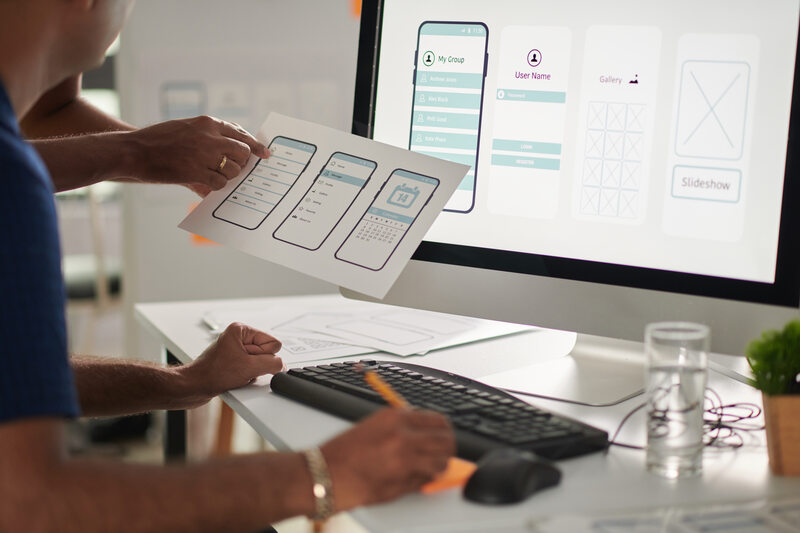Mobile user experience (UX) design has become a key component in the success of digital products. But with its opportunities to bring revenues and business growth are several challenges. In particular, they can maximize a platform’s strengths and minimize its drawbacks.
If you want to learn about these challenges and opportunities, read the article below!
As a project manager for your organization, one of your primary jobs is understanding the unique challenges and opportunities. An expert UI/UX design agency knows how to balance these two sides. This way, you can:
- Set the right expectations
- Make the best decisions within tight timelines
- Deliver a successful product that meets customer needs and achieves company objectives
Understanding Mobile UX Design
Mobile UX design creates and optimizes users’ overall experience when interacting with a mobile application or website on their smartphones or tablets. It is based on the following principles:
- Clarity and simplicity. Users can easily understand and navigate the interface without confusion. This includes using clear typography, concise content, and logical navigation structures.
- Consistency. It means that the look and feel of an app or website remain the same whether users access them on their mobile devices or desktops. Doing this helps provide a seamless user experience and reinforce brand identity.
- Responsive design. Mobile UX design elements, such as layouts and images, adapt to various screen sizes and orientations.
- Touch-friendly interface. Design elements, such as buttons, links, and form fields, are large enough and spaced appropriately to accommodate touch interactions on smaller screens.
- Efficient navigation. Mobile UX design allows users to quickly access important sections or features, with minimal clicks or taps. This may include implementing features like hamburger menus, tab bars, or swipe gestures.
- Fast loading times. Most Internet and app users have a short attention span. The best platforms with mobile UX are accessible within a few seconds. Otherwise, people can leave. After all, they have several choices.
- Accessibility. The mobile app or website does not discriminate. It is usable even for people with disabilities or impairments.
Want to elevate your UX and UI and leave a lasting impact on your audience?
Contact Growth Hackers
Why Mobile UX Design Matters for Businesses
A well-designed mobile UX encourages users to engage with your app or website consistently. This increases the likelihood of repeat visits, longer session durations, and higher conversion rates.
Further:
- Providing a positive mobile user experience leads to increased customer satisfaction and loyalty. Almost everyone does not say no to convenience, ease of use, and time-saving solutions. Even better, when your users become loyal customers, you can nurture them further to be your brand advocates.
- Optimized mobile UX design can lead to higher conversion rates. You remove the barriers that delay them from taking action, whether it is to buy or sign up for newsletters.
- Search engines like Google implement mobile-first indexing. It suggests it uses your site’s mobile version for ranking. When your page is optimized for this real estate, you can appear on the first page or even the first results. That gives you the best chance to get an incredible click-through and, later, conversion rate.
- Investing in a well-designed mobile UX can reduce the need for costly redesigns or updates due to poor user experiences and negative feedback.
Unique Challenges and Opportunities in Mobile UX Design
In the ideal world, you can build or optimize an app or a site for mobile with great ease and speed. It hits all the UX design principles and generates your business with a steady cash flow and growing profits.
In reality, it comes with limitations that can hinder scalability or usability that a UX design agency should address. In this section, the article tackles these challenges and provides insights into the strategies designers apply to overcome them.
1. Limited Screen Size
On average, desktops measure 19 inches diagonally. Mobile devices are a lot smaller. Tablets have screen sizes spanning only 10 inches. Smartphones definitely fare worse at only 4 inches.
Small sizes mean portability, suggesting anyone can now access the Internet, apps, and documents anytime, anywhere.
On the downside, a UX design agency must prioritize the most important information and features while maintaining a clean and uncluttered interface.
Solutions: A UX design agency follows Google’s Core Web Vitals, focusing on visual stability, mobile performance, and responsiveness. For example, one can optimize the pages for the first-input delay. Lazy loading of the content also helps, unless it should be above the fold.
2. Touch Interaction
Mobile users often struggle with accurately tapping small interface elements, leading to accidental taps or difficulty interacting with the intended element. That’s why mobile optimization is vital in website design.
Further, unlike physical buttons, touchscreens do not provide tactile feedback. This makes it difficult for users to know if their touch input has been registered.
Touch interaction also allows for gestures such as swipes, pinches, and long presses. However, these may not always be intuitive or discoverable for users, leading to confusion or inconsistent interactions.
Solutions: A UX design agency must consider button size, spacing, and placement to accommodate varying finger sizes and improve touch accuracy. They can also incorporate visual or auditory feedback, such as highlighting tapped elements or providing click sounds.
Elevate your mobile UX design today and pave the way to success!
3. Performance and Data Constraints
According to Google, a website should be accessible within three seconds. Otherwise, most users will likely close the tab and move on to others.
While they may be more patient with apps, those riddled with bugs and slow speeds can be equally off-putting.
Mobile devices also often have less processing power than desktop computers. This can impact the performance of complex animations, transitions, or interactive elements.
Sometimes the issue stems from the users, who may have limited data allowances or face slow network connections.
Solutions: A capable UX design agency can compress images, minimize code, use efficient file formats, and leverage caching techniques to reduce load times. Implementing data-driven UX design will help you improve your user experience but also help you achieve measurable results. They can also balance resource-intensive features with the need for smooth performance on a range of devices and offer options for lower-quality content or offline access.
Mobile UX design still has a lot of mountains to tackle, so to speak. But it is (and will always be) worth pursuing for the many opportunities it opens.
These include:
- Personalization. Mobile devices are personal gadgets that users carry with them all the time. You can maximize this to personalized experiences based on user preferences, location, behavior, and device capabilities. All these can translate to a pleasurable user experience and customer retention.
- Location-based Services. With built-in GPS capabilities, mobile devices enable location-based services and features such as local search, navigation, and contextual offers. This is helpful in relation to personalization. For instance, you can provide relevant content, recommendations, and services tailored to the user’s location and spur-of-the-moment need.
- Push Notifications. Mobile devices allow businesses to send push notifications, offering a direct communication channel with users. An expert UX design agency can use this feature to deliver timely and relevant information, promotions, or updates, driving user engagement and retention.
- Gesture-based Interactions. Touchscreens enable many gesture-based interactions, such as swiping, pinching, and tapping. A UX design agency can use these intuitive gestures to create immersive and interactive experiences beyond traditional point-and-click interfaces. For instance, simple apps can expand to include gamification or integrate other innovations such as augmented reality (AR).
- Device Integration. Mobile devices come with various sensors and hardware features. Examples are cameras, microphones, and accelerometers. You can integrate these capabilities into the UX design and offer context-aware experiences like voice commands and motion-based interactions.
- Social Integration. The likes of tablets and smartphones facilitate easy access to social networks. It enables a UX design agency to integrate social features such as sharing, liking, and commenting. From a marketing perspective, all these help increase user engagement, brand visibility, and organic growth.
- Mobile Commerce. The convenience and ubiquity of these nifty devices have led to the rapid growth of mobile commerce. Designing a seamless and secure mobile shopping experience can drive sales, customer loyalty, and overall business growth. These include features like one-click checkout, safe and secure payment gateways, easy refunds/returns, etc.
- Micro-interactions. Micro-interactions are small animations that provide feedback or confirmation when users interact with a UI element. These subtle interactions make the user experience delightful and engaging while enhancing accessibility. Examples of micro-interactions include notifications, progress bars, hover effects, etc.
Taking Your Mobile UX Design to the Next Level
Mobile UX design is new, so it is not surprising that it deals with many gaps and barriers. The good news is it is likely here to stay, and with the latest and upcoming technologies, you can improve the user’s experience and create a more curated, personalized shopping journey.
The right blend of creativity, technical knowledge, and a user-centric approach can also lead to stunning results that will help your brand stand out from the competition.
In the end, mobile UX design is all about understanding how users interact with your website or app and taking the necessary measures to improve their experience. This will help you create a seamless, intuitive user interface that meets the needs of today’s consumers.
Growth Hackers is a leading mobile apps marketing agency helping businesses from all over the world grow. There is no fluff with Growth Hackers. We help entrepreneurs and business owners supercharge their app with mobile ux design, increase their productivity, generate qualified leads, optimize their conversion rate, gather and analyze data analytics, acquire and retain users and increase sales. We go further than brand awareness and exposure. We make sure that the strategies we implement move the needle so your business grow, strive and succeed. If you too want your business to reach new heights, contact Growth Hackers today so we can discuss about your brand and create a custom growth plan for you. You’re just one click away to skyrocket your business.






